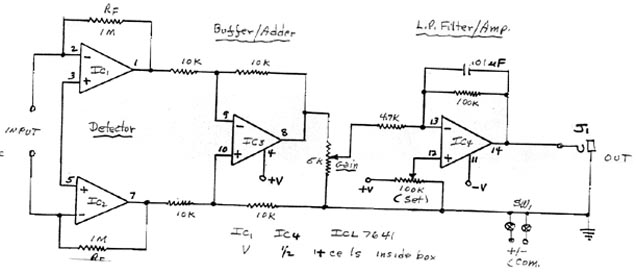Remarks on the IA-type of GW Detector, Circuit #10,000-B
(1-2-1994)
I. Remarks on the IA-type of GW Detector, Circuit #10,000-B
A. Preliminary tests of the instrumentation amplifier type (IA) GW detector circuit #10,000-B indicated that the signals "heard" on this unit are very much alike those heard on Geiger Counters! This seems to imply that perhaps radioactivity effects might be "set off" by these GW signals?
B. Some speculative thoughts on this:
1. Possibly the GW signals present at each zenith-nadir line on earth generate the "impulses" needed to "excite" the radioactivity events?
2. The type of signals being "heard" on the IA-type detector at this location should also be available at every other individual zenith-nadir line on earth!
3. Each individual "impulse" is a rhysmonic vector force and thus should easily be physically located well within the realm of an atomic nucleus.
4. The energy of such rhysmonic impulses could thus be possibly transferred to certain atomic nuclei which are momentarily unstable to enable the observed radioactivity. This should be possible since we know that GW signals also react with matter (mainly nuclei) to cause the observed gravity acceleration and the reaction in these capacitive detection elements. The actual process needed for the radioactivity, however, requires further study.
II. Conclusions
This appears to be a viable area for further study investigation and it could turn out to be of great importance. It would be nice of a few of you could try the experiment and see if you could confirm my observations here. When time permits I will try some other devices and continue some studies here also.
Figure (1): Simple Differential-Amplifier Type GW Detector
Prototype Circuit # 10,000-B (Tested 10-28-1993)

Note 1: Input device must be current generator. Will coils work here? Evaluated with capacitors over range of 0.1 uF to 3000 uF works okay here.
Note 2: LP filter is now raised to a cutoff of about 100 Hz.
Remarks:
(1) Circuit #10,000-B is constructed within an aluminum box but the detector "device" input is brought out in pin jacks -- to facilitate test of other devices.
(2) Used matched 10k resistor in the buffer stage (best CMMR).
(3) Circuit swings +/1 around 0 volts; set control was added to enable use with positive input chart recorders.
(4) Circuit is basic instrumentation amplifier.
(5) Circuit is very sensitive (large outputs).